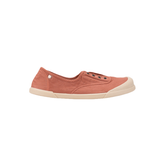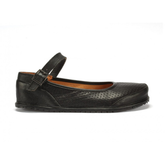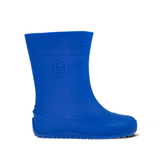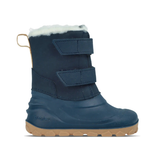Why Barefoot Shoes?
Finding shoes that comfortably fit my daughter's feet was a complete nightmare. She must have had the widest and chubbiest little feet I had ever seen! For months, we tried a variety of wide width and extra wide width shoes to no avail.
After many attempts, I began to notice that I was altering the shape of her toes. Her poor little pinky toe began curving underneath her other toes!
I was mortified. As a mother, I want what's best for my children, and the shoes I was trying to fit her in were definitely not that. Finally, after many long nights of searching online for appropriately fitting shoes, I stumbled across the minimalist shoe movement!
I learned minimalist shoes are designed with a naturally wide toe box; there was no need to buy wide or extra wide shoes for her anymore! My search finally came to an end. I discovered that I was wrong all along. It wasn't that her feet were abnormal, it was that "regular" shoes were!
As I delved into the world of minimalist shoes, I learned that they have other qualities that benefit not only our feet but our whole body. As a human race, wearing "traditional" shoes is a relatively new thing in our history. Our ancestors ran barefoot or had thin layers of hide around their feet that barely resembled modern shoes.
Our feet and bodies were designed to be able to withstand life without shoes. Human's soles, arches, muscles and joints all benefit appropriately from being barefoot. Minimalist shoes, also known as barefoot shoes, retain the benefits of barefoot walking while providing a protective barrier from hazards.
Barefoot (minimalist shoes) have the following qualities:
- No Heel Rise
- Flexible Soles
- Little or No Cushioning
- A Wide Toe Box
- No Toe Spring
1. NO HEEL RISE- ZERO DROP
Nearly every shoe on the market has some degree of heel-rise. This is a huge issue because by changing the angle on which you walk, you're changing the way your muscles and joints are positioned.
I am not just talking about stiletto's, even a slight heel raise can affect your entire body. Just a ½ inch heel-rise causes calf muscles to contract continuously, the hips to slide forward, and the neck muscles to engage. Take a look at the illustration below to see how wearing heels alter the body. In order to stay upright and not fall, our muscles and joints end up over-working to keep our bodies balanced.

The effect of a heel-rise is even more significant in children than in adults because they are not as tall and have shorter feet. This increases the angle they have the compensate for. Yes, its physics! Find shoes for your children that are the equal height from the toe to the heel (also known as zero drop). Doing this ensures that the muscles being used to walk, run, and play are the right muscles for the job.
2. FLEXIBLE SOLES
When we walk with bare feet, our soles connect with the ground. This connection allows the 7,000 nerve endings in each foot to collect sensory information about our environment.
By feeling changes in terrain and surfaces, our soles adapt, build strength, and help us balance. When these nerve endings are covered up with artificial arch supports and thick rigid soles, most of that valuable information is lost.
Did you know that APA (American Pediatric Association) recommends that babies and toddlers remain barefoot or wear soft sole shoes for as long as possible? It's because the nerve endings in baby's feet give them the information they need to balance and coordinate gross motor movement patterns. Bare feet give children the confidence to navigate their world through their sensations! Let them feel the earth beneath their feet.
3. LITTLE OR NO CUSHIONING
Most traditional shoes have a rigid sole and are overly cushioned. A stiff sole impedes the strengthening of foot muscles while having cushioning further amplifies the problem.
Cushioning in our shoes is not necessary to be comfortable. Putting your foot in an overly cushioned shoe makes your foot muscles relax. When your foot muscles relax, they will begin to atrophy over time like an arm in a cast. Not developing proper strength in your feet and arches creates a whole-body alignment and posture problems.
It is vital to start little ones off with minimalist shoes because they are born with pliable feet that continue to harden up to age 10 or so. By making their feet work naturally, they will develop the proper strength in their muscles and arches. If we want strong, healthy arches, we need to mimic barefoot walking as much as possible.
Check out this compelling video that demonstrates how traditionally stiff, padded shoes impede the natural ability of a new walker.
4. WIDE TOE BOX
Modern footwear has tapered, narrow toe boxes that alter the form of our feet. By changing the appearance of feet, the surface area and amount of contact that our feet have with the ground is reduced. In the long run, this will cause problems with balance and alignment.
Compromising our alignment means changing the way our hips and spines support our bodies. This can cause issues in the way we balance and harm our coordination. Our feet are our base, our foundation, to hold the entirety of our body up. You wouldn't teach your kids to build their tower starting with a small unstable surface area, but rather a large strong foundation.
This image shows the effect modern footwear has on our feet.

(Image courtesy of Vivobarefoot vivobarefoot.com)
This article on American foot binding helped shaped my way of thinking on footwear.
5. NO TOE SPRING
Toe spring occurs when the toes of the shoe curl upward. If it requires a lot of pressure to keep the toes down flat to the ground, your feet are working in ways they were not designed to. Shoes with toe spring can change your gait, or the way you walk. This change in your gait causes different muscle groups to work unnaturally, throwing your muscles, joints and tendons out of alignment.
Barefoot shoes are designed to fit our feet the way they are. They protect our feet from the environment while accommodating our natural shape and development. Let's nurture our feet and support our natural soles and strengthen bodies by wearing barefoot shoes!
- Choosing a selection results in a full page refresh.







